Years ago, I used to cry to Dr. Husband that my hair was falling out. Washing it was pure torture because of how much came out. I was also exhausted, constantly cold, and my nails were weak and would split. Sure enough, a blood test revealed an iron deficiency anemia, and I was prescribed iron supplements.
Those f’ing supplements were the pits; the made my stomach a mess. Even worse, after three months, my iron levels had barely moved. WTF. So I started doing my own research and came up with a far better plan of action: cooking with cast iron.
Cooking with cast iron can increase the iron content of your dishes by up to 80 percent. This means that by simply cooking with cast iron, you can reduce iron deficiency anemia without supplements.
The iron in cast iron cookware is made-up of the same iron that our bodies use. You know, the iron of which a deficiency can cause:
- headaches
- fatigue
- brittle nails
- hair loss
- weakness
- cold hands and feet
- shortness of breath
I tested out the theory. Sure enough, before my next blood draw, my hair stopped falling out! I also had more energy and my nails stopped peeling and breaking as easily. Come the blood test, of course my levels had increased significantly and were now within normal range.
You may have read claims that because the iron released is nonheme (it doesn’t come from an animal), it won’t be absorbed. That’s just nonsense.
Doctor Husband weighs in:
While true that nonheme iron is not as well as absorbed as heme, the addition of ascobric acid to nonheme iron will allow the nonheme to be equally as well absorbed as heme iron.1 Meaning, when the two elements, nonheme iron and abscoric acid, are combined, the iron absorption will be parallel to that of the absorption of heme iron.2 3 Further, there is strong evidence relating even greater effects than iron absorption with the addition of ascobic acid to nonheme iron: It’s also processed and used more efficiently.4
In english, what he’s saying is: Serve or cook with foods high in vitamin c when you use cast iron, including:5
- Papaya 224%
- Bell Peppers 157%
- Broccoli 135%
- Brussels Sprouts 129%
- Strawberries 113%
- Pineapple 105%
- Oranges 93%
- Kiwi 85%
- Cantaloupe 78%
- Cauliflower 73%
- Grapefruit 59%
- Parsley 54%
- Tomatoes 33%
- Lemon/Limes 31%
- Spinach 24%
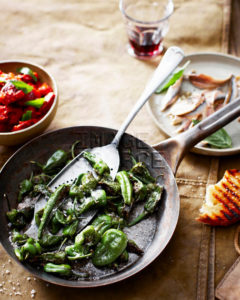
Cooking with cast iron is much different than other methods. But once you get the hang of it, you’ll never go back, especially if you’re lazy like me and buy one that’s pre-seasoned. Here are the iron basics you should know:
- That sucker gets hot. Handles too. Be careful. If your pan doesn’t come with a silicone handle cover, get one;
- Let the pan get HOT before using it. Then coat the bottom using either oil or water, and let that get hot too; and
- Get kisses for cooking delicious food.
Note: Use oil appropriate for medium-high- to high-heat cooking, like grapeseed, sunflower, or safflower. My favorite is this oil.
My first experience with cast iron was awful; everything stuck to the pan and I couldn’t clean it. Yea, that was all my fault. When used properly, your food won’t stick and you’ll spend a fraction of the time you spend cleaning other cookware.
Cleaning basics:
- Don’t use soap. All you need is a chainmail scrubber and this organic bamboo pan scraper, both of which won’t ruin the seasoning (the natural nonstick surface).
- In this picture below, I sautéed spinach using only water — not a drop of oil. That food was STUCK.
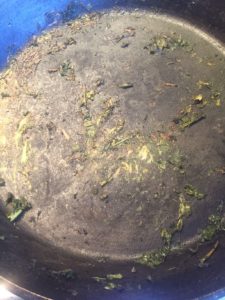
- While leaving the pan on the stove, fill a up a glass of water and pour it into the pan, just enough to coat the bottom;
- Leave the pan on the stove long enough to heat back up — even though the stove is off, it was still hot enough;
- After a few minutes, pour the water into the sink and let the pan cool there; and
- Once cool, use the chainmail scrubber to effortlessly wipe away the food.
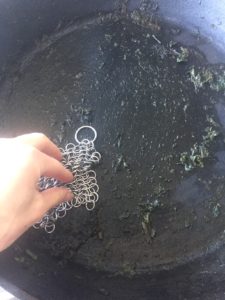
- Rinse the pan and the food came off without any effort.
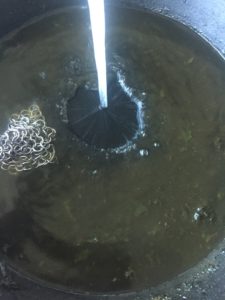
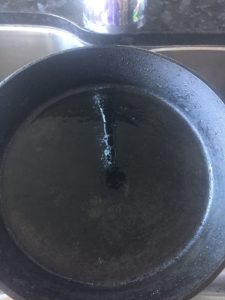
- Stick the pan back on the stove — which is off, but still hot — and let it dry. Don’t let the pan air dry, as the moisture isn’t good for it. Use the stove and turn it back on if you need to.
- If you notice the food sticking more than usual, put a layer of oil on the bottom. Use whatever you have in the house that’s the cheapest and suitable for high-temperature, like grapeseed, avocado, sunflower, or safflower. That’s it. Some people put it in the oven afterwards to seal in the oil, I don’t do this.
Some people prefer enameled cast iron, but the char, taste, and health properties of the plain old stuff our grandparents used is best. If you suffer from iron deficiency anemia, make the switch and toss those nasty supplements.
Got a question? Leave it below.
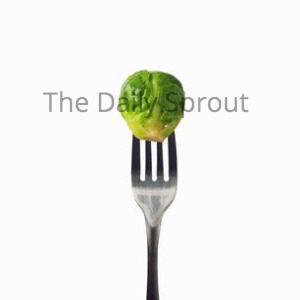
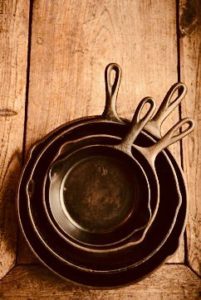





Loved your article, very informative. Can’t wait to buy an iron skillet and try some recipies
Wow!!! Your food looks amazing and this is amazingly well written. Thank you!!!